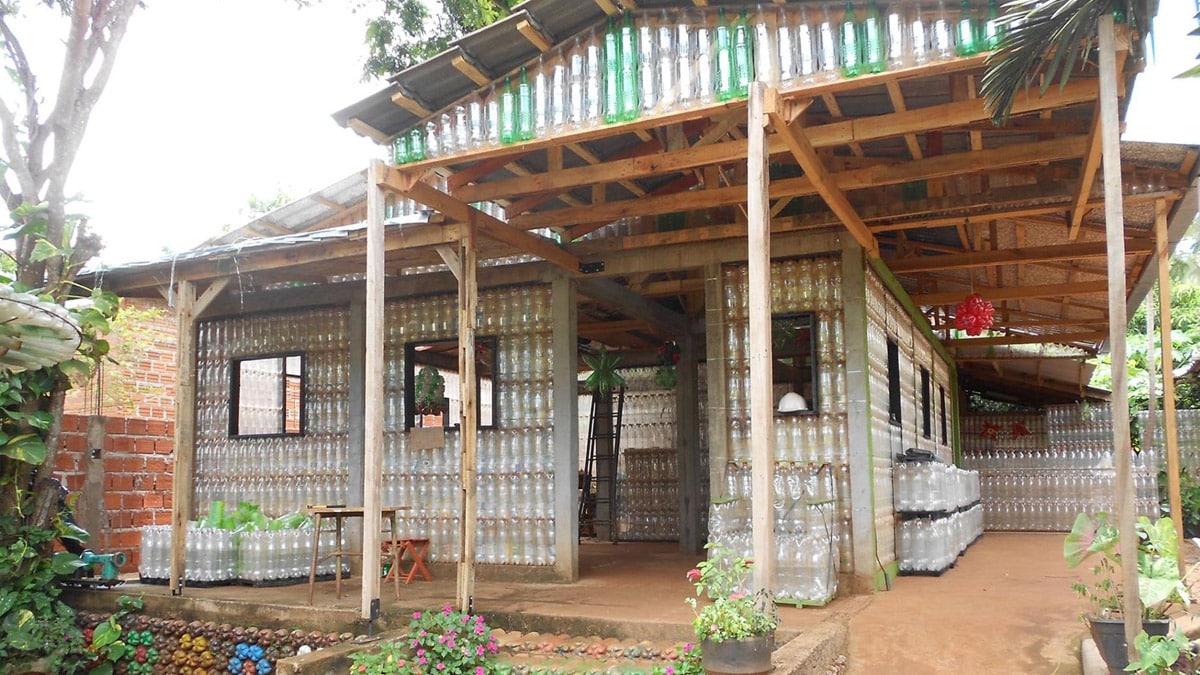The Powerful Impact of Recycled Materials in Construction

As the world pivots towards sustainable living, the construction industry is stepping up by embracing recycled materials, a transformative approach that marries environmental responsibility with innovative building practices. In the realm of construction, recycled materials refer to the repurposing of elements that were once integral parts of other structures or products, taking on new life in the creation of modern, eco-friendly edifices.
From the rubble of demolition emerge valuables such as reclaimed concrete, repurposed brick, and a myriad of other materials salvaged from their previous existence. These eco-centric treasures are not merely tokens of sustainability but are proving to be practical, functional, and aesthetically pleasing components in contemporary construction projects.
Join us as we delve into the heart of an industry revolution, where the old becomes new, and every material holds the potential for rebirth within our built environment.
Advantages of Recycled Building Products
As the construction industry evolves, there is a growing emphasis on sustainability, where recycled materials play a pivotal role. Let’s explore the advantages of using recycled building products in construction projects.
The use of recycled materials in construction offers significant environmental benefits. By repurposing materials that would otherwise end up being disposed on in a construction skip bin, we reduce the environmental impact of waste. Moreover, recycling conserves natural resources by decreasing the demand for virgin materials, which often helps preserve habitats and reduce soil degradation due to mining or deforestation.
Recycled building products often contribute to energy efficiency. The process of recycling materials generally consumes less energy compared to the extraction and processing of new materials. For instance, recycling aluminium uses about 95% less energy than producing it from raw bauxite. This reduced energy demand further diminishes the carbon footprint of construction projects, fostering a sustainable building environment.
A comprehensive cost-benefit analysis indicates that recycled materials can be economically beneficial. Although the initial cost of recycled materials may sometimes be higher, long-term savings can be realized through the reduction of disposal costs, lower energy expenses in production, and potential government grants for green building practices. In the broader picture, the cost-effectiveness of recycled materials can be a significant driver for developers and contractors aiming to balance fiscal responsibility with environmental stewardship.
- Reduced Waste Disposal Costs: Recycling construction materials minimises waste and can help keep construction sites clean, lowering the fees associated with waste disposal.
- Lower Production Costs: The energy savings from using recycled items lead to lower production costs, which can be passed on to consumers.
- Incentives for Green Building: Government and private institutions may offer financial incentives for the use of sustainable materials, adding to the cost benefits.
A Green Step Forward: Material Life Cycle Assessments
Understanding the environmental impact of materials throughout their lifespan is crucial in promoting sustainability within the construction industry. A Life Cycle Assessment (LCA) is a methodology used to assess the environmental aspects and potential impacts linked to a product, process, or service. By taking into account all stages from raw material acquisition through production, use, and disposal, the LCA provides a comprehensive view of a material’s ecological footprint.
The Life Cycle Assessment Process
An LCA involves several key steps:
- Goal and Scope Definition: Setting the boundaries and objectives of the study.
- Inventory Analysis: Compiling an inventory of relevant energy and material inputs and environmental releases.
- Impact Assessment: Evaluating the potential environmental impacts associated with identified inputs and releases.
- Interpretation: Assessing the results to make informed decisions to reduce environmental impacts.
The outcomes of an LCA for various recycled materials can be enlightening, often revealing benefits over their non-recycled counterparts. For example:
- Recycled Steel: Reduces energy consumption and emissions because the energy required to produce recycled steel is much less than that needed for virgin steel.
- Recycled Concrete: Diverts waste from landfills, saving council tip charges, and cuts down on emissions from producing new concrete.
- Recycled Glass: Consumes less energy in production and reduces the volume of raw materials needed, thus preserving natural resources.
- Recycled Plastics: Often uses less energy than producing new plastics and can reduce fossil fuel usage and greenhouse gas emissions.
By conducting LCAs on construction materials, industry professionals can make informed choices that support sustainability and reduce the overall environmental impact of their projects. This decision benefits the environment and can result in long-term economic gains for the stakeholders involved.
Turning Waste into Worth: Innovative Recycled Building Products
The construction industry is undergoing a transformative shift as innovative recycled building products are steadily carving out a place in the market. These products are not just eco-friendly alternatives; they represent a critical step in the circular economy, turning what would otherwise be waste into valuable construction materials. We’re witnessing groundbreaking advancements both in Australia and around the globe where industrial by-products are getting a second life in building sector.
Innovative Recycled Products in Australia
Australia has been at the forefront of adopting recycled materials for construction. Products such as recycled concrete and plastic composites are proving that recycled materials can match and even surpass the durability and aesthetics of traditional construction materials.
- Recycled Concrete: Companies down under have mastered the art of utilizing demolished concrete as an aggregate for new concrete, reducing the need for freshly quarried materials.
- Plastic Composites: Utilising discarded plastics, Australian companies are producing robust composite materials that serve as a sustainable alternative to wood and steel in some applications.
Global Innovations in Recycled Building Products
Globally, creative solutions for building materials are becoming a staple as various industries seek to reduce their environmental footprint. Countries worldwide implement novel methodologies to give new life to industrial waste products.
- Insulation from Denim: Old denim clothing has a new purpose as companies transform the fabric into effective building insulation.
- Glass Foam Aggregate: By-product of glass processing is used to create lightweight aggregate for construction, enhancing thermal insulation properties.
- Rubber from Tires: The rubber from old tires, usually a troublesome waste, is now being repurposed into floor mats, playground surfaces, and even as an asphalt additive for road construction.
In conclusion, these innovative products showcase just a snippet of the possibilities recycled materials present. By converting industrial waste into sustainable construction products, we are building a future where waste reduction and resource efficiency are ingrained in every building that shapes our skyline.
Construction and Demolition Waste: Management and Minimisation
Construction and demolition (C&D) projects generate a significant amount of waste, but applying effective management and minimisation strategies can lead to more sustainable practices. By reducing waste, not only do we alleviate the pressure on landfills, but we also conserve natural resources and reduce greenhouse gas emissions associated with manufacturing new materials. Let’s discuss how we can curb the waste in construction and understand its pivotal role in a greener building environment.
Strategies for Reducing Waste in Construction
Adopting a proactive approach to waste reduction begins with planning and carries through to the final stages of a construction project. Here are several strategies:
- Designing for Deconstruction: Structuring buildings to be easily disassembled allows materials to be reclaimed and reused at the end of the building’s life.
- Material Optimisation: Using advanced software to predict and optimize material requirements can significantly reduce over-ordering and wastage on site.
- On-site Practices: Training the construction team in sustainable practices such as sorting waste, using returnable containers, and reducing packaging can lead to significant waste reduction.
Importance of Proper Construction Waste Management
Effective waste management in construction goes beyond compliance with legislation; it is a key component for sustainable development in the industry. Proper waste management:
- Conserves Resources: By recycling and reusing building materials, we lessen the demand for new resources and reduce the environmental impact of extracting and processing them.
- Reduces Environmental Pollution: Thoughtful waste management prevents hazardous materials from contaminating the soil and water, thus protecting the ecosystem.
- Supports a Circular Economy: Implementing waste hierarchy principles—reduce, reuse, recycle—helps keep materials in use for as long as possible, promoting a shift towards a circular economy in construction.
In sum, embracing efficient strategies for waste management is not only environmentally imperative but also economically beneficial in the long term. By prioritising the reduction of construction and demolition waste, the construction industry can take a significant leap towards sustainability and corporate responsibility.
The Concrete Benefits of Recycled Materials
Recycled materials are revolutionizing the construction industry, offering a sustainable solution to traditional building practices. Among these innovative options, recycled concrete is paving the way towards eco-efficiency and structural integrity. Thanks to cutting-edge processes, concrete debris from demolished structures is now being repurposed, reducing landfill waste and fostering a circular economy.
Recycled concrete aggregates (RCA) originate from the rubble of demolished concrete structures. After being crushed and processed, RCA serves as a valuable resource for new construction projects, laying the groundwork for a more sustainable and resilient built environment. RCA decreases the consumption of virgin materials and reduces the carbon footprint associated with the extraction and transportation of raw resources.
Crossing the chasm between theory and practice, numerous case studies highlight the success of incorporating recycled concrete into new structures:
- Urban Revitalisation Projects: Cities around the world are utilizing RCA for the construction of pavements, curbs, and pathways, enhancing urban landscapes while mitigating environmental impact.
- Commercial Developments: Forward-thinking developers employ recycled concrete in the foundation layers of large-scale buildings, proving its load-bearing capabilities and sustainability merits.
- Residential Innovations: Homebuilders integrate RCA into residential projects, showcasing the material’s versatility and contribution to green certifications.
These cases affirm that the practical application of recycled materials in construction benefits the planet and reinforces the durability and lifecycle of the built environment. Reduced construction costs, minimised environmental impact, and innovative building solutions define the concrete benefits of recycled materials, marking a significant stride in pursuing sustainable construction practices.
Global Triumphs in Green Building: Recycled Materials Making a Mark
Exploring a series of innovative projects worldwide, we celebrate the triumphs of recycled materials in the construction industry. These remarkable case studies not only set new benchmarks in sustainability but also inspire a future where green building is the norm.

The Bottle House – Argentina
In the heart of Argentina, a unique initiative transformed over 25,000 plastic bottles into ‘The Bottle House’. This project is a beacon of ingenuity, employing not just bottles, but also other recovered items like car tires and CDs, to create a sustainable structure that both fascinates and educates.
- Environmental Impact: Reduction of solid waste by repurposing non-biodegradable materials.
- Techniques Used: Community collection and workshop-based bottle processing.
Earthship Biotecture – Global
Earthship Biotecture has become synonymous with sustainable building practices. These off-grid homes are constructed using a mix of recycled and natural materials, showcasing how construction can harmoniously co-exist with the environment.
- Environmental Impact: Minimization of the project’s carbon footprint by utilizing low-impact construction materials.
- Strategies: Earthships incorporate thermal mass construction and on-site renewable energy sources for temperature stabilisation.

The EcoARK Pavilion – Taiwan
Taiwan’s EcoARK Pavilion, an architectural marvel, is fashioned from 1.5 million recycled plastic bottles. This structure not only stands as an example of sustainable construction but also withstands natural disasters better than many traditional buildings.
- Environmental Impact: The pavilion’s use of recycled POLLI-Bricks promotes a drastic reduction in plastic waste.
- Innovations: Development of a recyclable building material that offers high resistance to natural forces.
The Recyclable House – Australia
Australia’s Recyclable House in Beaufort shows that a home can be beautifully designed and environmentally conscious. Built with the end of its life cycle in mind, the house is a testament to reducing, reusing, and recycling in the built environment.
- Environmental Impact: Construction gears towards zero waste with a careful selection of recyclable and sustainable materials.
- Sustainable Practices: Implementing a modular design for ease of dismantling and repurposing components.
These global successes paint a picture of a world where construction is not just about erecting structures but about nurturing the environment. From proactive waste reduction initiatives to creative repurposing, incorporating recycled materials into construction is paving the way for a brighter, greener future.


